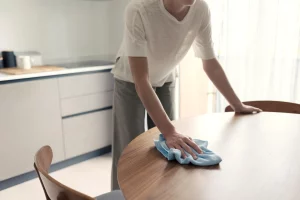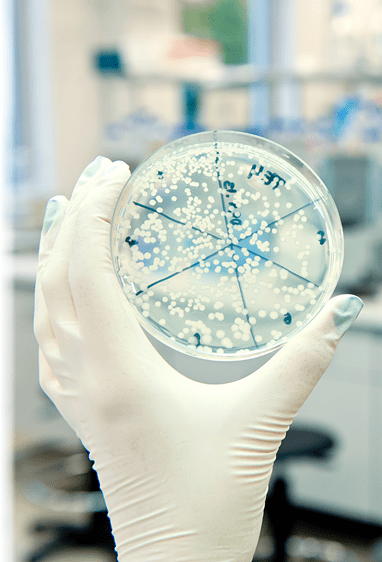Updated: July 2023
Germs are all around us (and on us!) and on every surface you can imagine, there is no way to escape them. There are some obvious culprits, such as toilets, door handles and rubbish bins that all contain nasty germs and dangerous bacteria. However, there are other common and every-day surfaces that have high levels of viruses and bacteria.
Researchers have found that the popular germ hotspots include money, can-openers, kitchen cloths, office keyboards and – perhaps surprisingly – pillows. Other favourite haunts for bugs include TV remotes, mobile phones, and petrol pumps. While not all germs are bad for your health, in this blog, we’ll take a look at common things you touch every day that are more germ-ridden than you may first think.
Table of Contents
Everyday Places & Items with More Germs than You May Think
Germs and Money
While we appear to be moving to a cashless society in the UK, there are still times we need to reach for our purse and use a bank note or coin to make payment. However, this could be classed as dirty money. Yes, you heard that right. Research in 2021 found that bank notes from across the globe were covered in all sorts of microbe colonies. When taking swabs of different bank notes, Canada was reported to have the “dirtiest” money with 209 microbe colonies discovered including harmful bacteria that can lead to food poisoning and even sepsis. And over in the UK, a pound coin was found to have seven microbe colonies.
So, when it comes to money – be it cards, notes or coins, always wash your hands after handling. If we all take precautions with proper hand hygiene, at each stage of money’s journey, there would be less microbes spread and less risk of cross contamination. Even something as simple as carrying effective hand sanitising spray around with you to use after handling money, you could reduce the risk of illness.
Can openers
You might want to check the last time your can opener was thoroughly washed as it’s one of the dirtiest things you touch every day. In a 2013 Germ Study by NSF International, 14 common kitchen items were tested for the presence of four different types of microorganisms: E. coli, Salmonella, yeast and mould, and Listeria. This study found that the humble can opener tested positive for Salmonella, E.coli, yeast and mould.
Kitchen cloths



The kitchen fridge
And let’s not forget about the kitchen fridge. In the workplace or at home, fridges will be opened numerous times per day. Don’t neglect the kitchen fridge and take the time to clean and disinfect it on the inside and out on a regular basis.
Computer keyboards
When was the last time you cleaned your keyboard? Chances are, it hasn’t been cleaned at all as people don’t tend to think about it as being particularly dirty. Keyboards can reportedly carry as many as 200 times the number of bacteria found on toilet seats, so wipe them down regularly with an antibacterial cleaner.
Your pillows and bedding
The bedroom should be a tranquil area for rest and relaxation, but you might not be so willing to rest your head if you knew your pillow was harbouring dirt, dead skin cells, and dust mites. The latter particularly thrive in warm climate. With England reporting record high temperatures in 2022, washing your pillow cases and bedding has become even more important. Advice by the Hygiene Council recommends washing bed linen weekly.
Your Handbag
Next time you reach in your handbag for your purse, you may be coming into contact with more germs than you may think. Handbags are one of the dirtiest items people touch yet you probably don’t think to clean them.
One study in 2013 found that there were over 10,000 different bacteria in a few square centimetres of a handbag!
Pet bowls & toys



Your desk
Your desk could be one of the dirtiest common items you come into contact with, hosting over 20,961 invisible microbes living and breathing on every square inch. The toilet seat, in comparison, contains just 49 grams per square inch. When you eat at your desk, you not only add to those germs, but you are eating them too. Now that’s food for thought!
Doorknobs, light switches, elevator buttons & escalator handles
When we don’t practice proper hand hygiene, surfaces such as door handles, elevator buttons, and escalator handles can become easily contaminated. In public spaces such as rail stations, airports and healthcare facilities in which these surfaces are often found experience high traffic and therefore, germs can rapidly spread. In one study of a Toronto hospital, elevator buttons had the highest bacteria count in comparison to door handles and flushes while every study on escalators and elevator buttons has found contamination of these surfaces.
Your mobile phone



In a 2017 study, a high medium bacterial count was found on secondary school students’ phones with over 17,000 gene copies per phone. The answer? Your best bet is to wash your hands frequently and think twice about taking it to the bathroom with you.
Germ Hotspots in Your Washroom
As a washroom hygiene service company, we couldn’t write a blog about common germ hotspots without mentioning the washroom. On average we spend around 11 days a year in our washrooms. That’s many hours spent surrounded by areas potentially full of dangerous germs and bacteria, and washrooms can be rife with them. Poor cleaning techniques and bad hand hygiene contribute most to high levels of germs and bacteria in washrooms.
Did you know that sinks harbour 250,000% more bacteria than flush handles and toilet seats are some of the cleanest areas within a bathroom? Maybe you’re focusing on the wrong areas and need to start considering areas you wouldn’t usually think of like mirrors, toilet roll holders, radiators, taps etc – of course, don’t forget the most obvious areas such as the toilet and floor. Keep your soap dispensers stocked and provide hand drying solutions so people can practice proper hand hygiene. Disinfect your washroom regularly and keep it looking sparkly clean to avoid any unwanted health issues.
Minimise the spread of germs
The fact is that whilst we can’t avoid germs and some are good for us, we can all follow good hygiene practices and protect ourselves and those around us from harmful infections and illnesses spreading.
